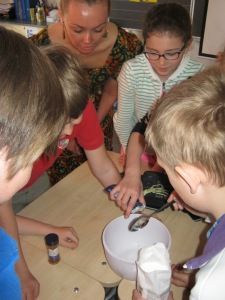Classes 4, 5 and 6 from Zanlerigu Primary took part of different school linking activities. From 7th to 11th of November.
Our friends from Estonia sent us a presentation about plants in their school yard. We looked at it with classes 6a and 6b and the Mondo teacher from Estonia was explaining the uses of these plants and some things about the climate and nature of Estonia. For us it is quite difficult to imagine a place than can be so cold at times. We made herbal tree from linden tree flowers and drank it together.
With class 6b we then went around our own school and talked about the ways we use the trees that are found here. The trees that we saw were Neem tree, Kapok, Flamboyant tree, Mahogany, Eucalyptus and Acacia. The most obvious benefit of all these trees is that they provide shade and coolness for us and our animals when the weather is very hot outside.
Some trees also have very special value for their beauty. For example in the beginning of rainy season the Flamboyant tree bears very decorative red flowers that are pleasing to look at. Flamboyant tree and Acacia belong to the the bean family of plants which means that they bear fruits that are stored on pods. These pods of seeds can be used to make different sounds and play music. These trees also have fern-like leaves that are made up of many small units attached to one leaf-stem.
The trees that have medicinal value are Neem tree and Mahogany. We can make tea from neem leaves, which can lower fever, clean blood, support liver function and much more. Around here people often use small sticks of neem tree to clean their teeth (the bark of neem is antiseptic and anti-inflammatory). The seeds inside neem berries can be used for making oil, which is widely used in production of cosmetics. This oil also has a use as natural insect repellent. Because neem is a fast growing tree it is also often used as firewood. Growing neem trees also makes the soil more fertile because the roots can grow very deep and bring minerals back to the surface of the ground.
Mahogany is a tree that is prized for the beautiful colour and texture of it’s wood. That is why it’s often used to make luxury furniture. Mahogany is a slow growing tree. We use the bark and sap of mahogany tree for medicine, especially to cure stomach pains. That is why when you see mahogany here, their trunks have many scars and holes in them. People routinely go to the tree to cut it and get medicine.
The Kapok tree has fruits that contain cotton like fibre. We use it to make pillows.
Eucalyptus is a tree uses up a lot of water from the ground, so people plant it to irrigate very wet areas.
After seeing all the plants and talking about them each student chose one tree and drew a picture of it also stating some of the uses of this tree.
With both classes 6a and 6b we read the letters from our friends from Kuristiku Gümnaasium and wrote letters about ourselves back.





































